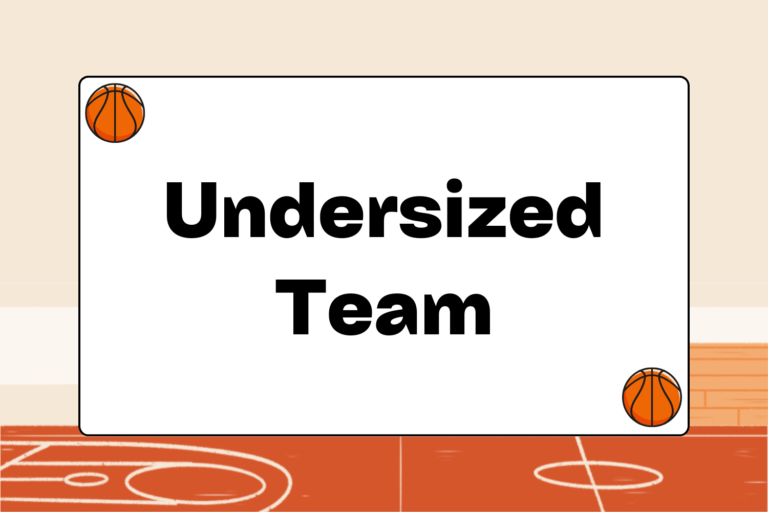As any veteran hoopster can tell you, the more offensive options you have, the better your chance of scoring. That’s why the pick-and-roll (also called the screen and roll) is one of the most effective plays in basketball. This highly potent play, in which two teammates — the ball handler and the screener — work in conjunction, creates several offensive options.
The ball handler can penetrate off the screen, use the screen to create space for an open jump shot, dish the rock to a teammate rolling towards the basket, or even avoid using the screen all together. The screen-and-roll creates an abundance of choices that makes it almost impossible to shut down.
So if you’re looking to kick-start your team’s offense, this play may be just what the doctor ordered. This guide covers everything you need to know to run the pick-and-roll to perfection.
What is the Pick-and-Roll?
The pick-and-roll is a classic basketball play in which a teammate sets a screen on the defender guarding the ball handler. Subsequently, the screener rolls towards the basket to create an additional offensive option. At this point, the ball handler has several options, thus making it much more difficult for the defense to contain.
Though it is a simple maneuver, each component must be executed flawlessly in order for the play to be most effective. Below is a brief breakdown of the most crucial components of the pick-and-roll:
The Screen
The most important part of the pick-and-roll is the screen (or pick). If the screener does not do a good job picking off the ball handler’s defender, then the play will quickly break down.
In basketball, a screen occurs anytime an offensive player attempts to block or re-direct a defender by positioning his body in the defender’s path. This is a legal maneuver as long as the screener remains stationary immediately before and during contact. Here are a few key points to keep in mind when setting the pick:
- Establish a wide base: It’s the screener’s job to stop a defender’s momentum, so you want to prepare yourself for contact. Assuming a wide base — feet spaced at least shoulder-width apart — will help you absorb the hit.
- Make contact: In order for a screen to be effective, you must make contact with the defender. However, avoid holding or pushing the defender because you can be whistled for the foul. Set the screen as close to the defender as possible to ensure you’re in the right position.
- Keep your hands to yourself: It’s a good idea to keep your hands tucked in close to your body. This will not only serve as a source of protection for the more tender areas of the body, but also will allow the officials to see that you aren’t pushing or holding.
The Ball-Handler
The dribbler is the engine that drives the play. In order for the play to begin, the ball handler must lead the defender into the screen. This is done by dribbling towards the player who is preparing to set the pick. The ball handler can help ensure the effectiveness of the screen by limiting the distance between himself and the screener as he dribbles past the pick.
Communication
A well-run pick-and-roll is always the product of excellent teamwork and communication. Because this play involves intricate timing and multiple players, both parties involved must be on the same page. Teammates don’t have to communicate verbally to run the pick-and-roll, but both players must be in tune to what is going on. It’s a play that must be practiced a great deal to master the timing.
Executing the Pick-and-roll
Now that you are familiar with the various parts of the screen and roll, it’s time to get on the court and execute. The steps outlined below are for the most elementary version of the classic play. Each step (with the exception of the final step) has been divided into two separate parts: a set of instructions for the dribbler and a set of instructions for the screener. Every player should be familiar with the roles of both positions.
Step 1: The Set-Up
- Dribbler: To set the play into motion, the ball handler will begin to dribble towards the area of the court where the screen will be set. Generally, this spot is pre-determined before the play begins, but the pick-and-roll can also be run impromptu; the key is communication. Both the dribbler and the screener must know where the pick is going to be set.
- Screener: As the player with the ball approaches, the player setting the screen will begin to move towards that spot on the court. The screener must be in place before the ball handler leads his defender into the pick.
Step 2: Wait for the Screen
- Dribbler: The dribbler is in somewhat of a stall mode until the screener gets properly set up. Once the screen is in place, the dribbler will explode towards the pick and lead his defender into the screen.
- Screener: The player setting the pick must make sure to be balanced and in position before making contact with the defender. Once you are set, wait for the ball handler to pass by you before making your next move.
Step 3: Get Open
- Dribbler: Utilizing the screen your teammate has set for you will create space between you and the defender.
- Screener: Stand your ground momentarily after contact is made, then quickly release from your position and roll towards the basket. If you set a good screen, chances are you can leave both your teammate’s defender and your own in the dust
Step 4: Make a Choice
The pick-and-roll is a popular play because it creates several offensive options. Once the ball handler comes around the screen, he will have the following options at his disposal:
- Pass to the player rolling towards the basket
- Take the open shot
- Pass to another open teammate
- Drive to the hoop
Shoot & Score!
There are countless variations of the pick-and-roll, but the basic components will remain the same. So take these tips to the court, and soon you’ll be a screen and roll expert. Just don’t be afraid of a little contact!





